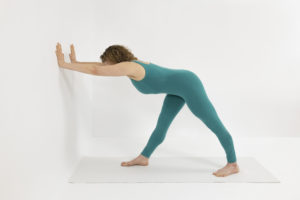
by Nina
“I was pitched a curve ball recently.
I love yoga, but am advised that I should longer do inversions due to the pressure on my eyes as I am at elevated risk for glaucoma. (There are a lot of inversions in a standard yoga practice – including forward fold and down dog…)
Inspired by one of my favorite yoga teachers who had a neck issue that forced her to change her lifelong practice when she was my age, I am going to look at this as an opportunity to practice my yoga, e.g., deal with this “bump in the road” with acceptance, adjustment, and equanimity.” —Sally
This week I saw the above posted on Facebook by a friend who is a reader of this blog. I commented that her approach to this news seemed like good one. Of course, I believe that accepting change rather than fighting with reality is always a good place start. But I also had lots of ideas for how she could adapt her poses and her practice to keep her eyes safe, so I told her that and she was enthusiastic to hear my ideas.
Rather than letting her know privately, I decided to write a post about it. After all, even though yoga’s inverted poses can be wonderful additions to your practice because they can be very calming, there are also certain health conditions for which they are contraindicated. In addition to glaucoma, these include uncontrolled high blood pressure, detached retina, and recent oral surgery. See Cautions for Inversions for information. And if you’re suffering from GERD (acid reflux), it seems like a good idea to avoid long-held inversions as well. So I thought there are probably quite a few of you out there who have been told you should no longer do inversions and that you, too, would like to see this information.
First, let’s look at what counts as an “inversion” in yoga because these are all going to be poses that you should either modify or avoid.
In yoga, any pose where your head is below your heart is an “inversion.” This includes full inversions, such as Headstand, Shoulderstand, and Legs Up the Wall pose, where your legs are higher than your heart and your heart is higher than your head.
This also includes partial inversions, where your legs are below your heart (typically because you’re standing on your feet) but your heart is above your heart, such as Standing Forward Bend and Downward-Facing Dog pose. I’m going to include some backbends where your head is dropped back in this category, too, because your head is below your heart in these poses as well.
You will need to avoid both partial and full inversions because they all put pressure on your head and can raise your blood pressure. Fortunately there are ways to modify many of these poses and for those you can’t modify there are some very good alternatives!
Partial Inversions
Downward-Facing Dog Pose (Adho Mukha Svanasana): Practice Half Downward-Facing Dog pose at the wall or with hands on a table or the back of a chair. Keep your spine elongated and parallel with the floor, and keep your head between your arms and in line with your spine.
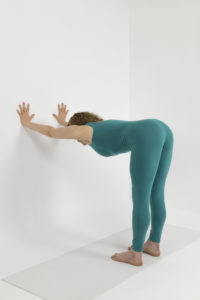
Standing Forward Bend (Uttanasana): Practice Half Standing Forward Bend pose with fingertips on the wall or on a table or the back of a chair. Keep your spine elongated and parallel with the floor, and keep your head between your arms and in line with your spine. (Sorry, no photo.)
Wide-Legged Standing Forward Bend (Prasarita Padottanasana): Practice Half Standing Forward Bend pose with hands on the wall or on a table or the back of a chair. Keep your head between your arms and in line with your spine. Or place your hands on blocks high enough so you can keep your spine elongated and parallel with the floor, as shown here:
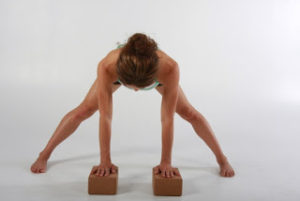
If you want to support your head the way you do in the classic pose, you can rest your forearms on a tabletop and rest your head on top of them like this: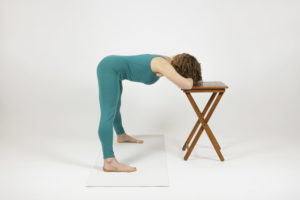
Pyramid Pose (Parsvottanasana): Practice Half Pyramid pose with hands on the wall or on a table or the back of a chair. Keep your spine elongated and parallel with the floor, and keep your head between your arms and in line with your spine.

Bridge Pose (Setu Bandha Sarvangasana): The only way to modify this would be to remove the backbend and to lie in Constructive Rest pose. This is what I’d do if I was in a class and others were practicing Bridge pose.
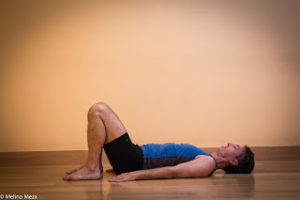
However, if you want to practice a similar backbend, Bow pose is the same shape only upside down! You can do the classic pose for an active backbend or try a supported version with a bolster supporting your lower torso like this: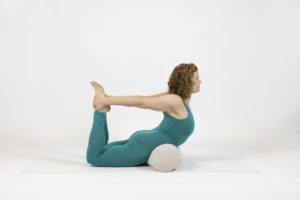 And if you want gentle backbend as restorative pose for calming, try Empress pose (Savasana with support under the chest and head) or Reclined Cobbler’s or Crossed-Legs poses with the same support.
And if you want gentle backbend as restorative pose for calming, try Empress pose (Savasana with support under the chest and head) or Reclined Cobbler’s or Crossed-Legs poses with the same support.
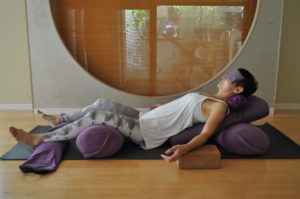
Camel pose (Ustrasana) and Upward Plank pose (Purvottanasana): Come into the backbend but keep your chin pointing toward your chest instead of dropping your head back.
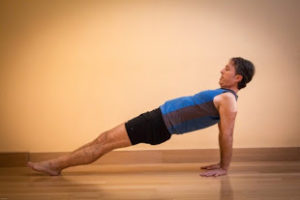
Upward-Facing Bow pose (Urdva Dhanurasana): Practice Bow pose instead.
Full Inversions
Legs Up the Wall pose (Viparita Karani): Simply eliminate the support under your pelvis. You can also add a thin blanket or folded towel under your head. Eliminating the support under the pelvis changes the pose into a partial inversion where there is no pressure on the eyes or head, but it can still be very relaxing. And inverting just your legs helps your circulation, among other things.
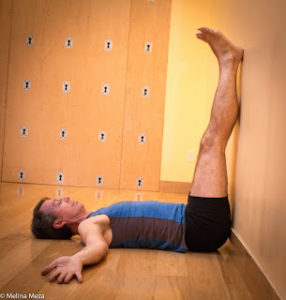
Headstand, Shoulderstand, and Plow: Practice letting go of these poses. For similar quieting effects, try seated forward bends with your arms and head supported on the seat of a chair. You can use any leg position that works for you. Hold for a least three minutes.
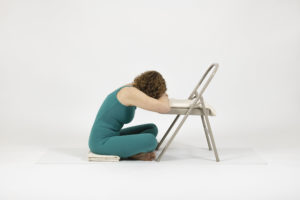
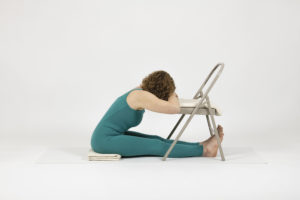
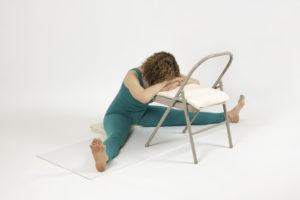
• Follow Yoga for Healthy Aging on Facebook and follow Nina on Instagram • Pre-order Yoga for Times of Change: Practices and Meditations for Moving Through Stress, Anxiety, Grief & Life’s Transitions here • Order Yoga for Healthy Aging: A Guide to Lifelong Well-Being here


This was very helpful for my older students Nina. Thank you!
Hi Nina, I just found this blog and I loved your article! I love props! They have really changed my practice and for the record I’m only 45. I’ve been practicing for years but when props got introduced into my practice it changed everything.